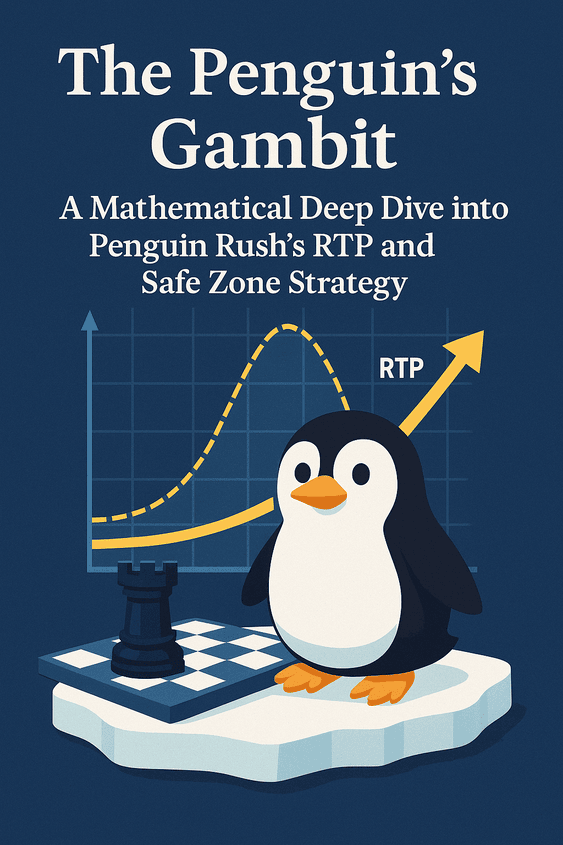In the world of iGaming, most players see the surface: the charming graphics, the rising multipliers, the thrill of the win. But savvy players know that beneath every great casino game lies a mathematical heart. Understanding this core logic is the key to moving from a hopeful player to a strategic one.
While games like Penguin Rush are celebrated for their interactive fun, their true genius lies in a sophisticated math model that rewards calculated risk. Today, we're putting on our analytical hats to dissect the engine that powers this leading Crossy-style game. We'll explore its dynamic RTP, the probability of each step, and—most importantly—the game-changing mathematics behind its Safe Zones. For insights into the psychological aspects that make this game so engaging, read our analysis of the psychology behind crash games.
The Foundation: Why Penguin Rush's RTP is Not What You Think
First, we must discard the old way of thinking about Return to Player (RTP). In a traditional slot machine, the RTP is a fixed, long-term average. A 97% RTP means the game is designed to pay back 97% of all wagers over millions of spins. Your choices don't change this number.
Penguin Rush operates on a more complex and engaging principle: Player-Influenced RTP.
The game is designed with a maximum theoretical RTP (for example, a highly competitive 97%). However, you only achieve this peak RTP by playing with a "perfect" mathematical strategy. Every decision you make—to take one more step or to cash out—directly impacts your effective RTP for your session. This revolutionary approach represents a significant evolution from traditional crash games to interactive player-influenced experiences.
It's the same logic that governs expert-level Blackjack. The game offers a 99.5%+ RTP, but only to those who flawlessly follow Basic Strategy. If you hit on a hard 20, your personal RTP plummets. In Penguin Rush, every step forward is a strategic decision with a direct mathematical consequence. Players interested in understanding how to apply strategic thinking to casino bonuses will find similar principles at play.
The Math of the Dash: Understanding the Probability of Each Step
At its core, Penguin Rush is a series of independent probabilistic events. Each time you click to move the penguin forward, you are challenging the game's Random Number Generator (RNG).
While the exact probabilities are proprietary to the developer (Upgaming), the logic is universal: The probability of survival decreases as the potential multiplier increases.
Let's illustrate with a hypothetical model:
| Step Number | Multiplier | Hypothetical Survival Probability |
|---|---|---|
| 1 | 1.25x | 98% |
| 2 | 1.55x | 97% |
| 3 | 1.95x | 96% |
| ... | ... | ... |
| 8 | 5.00x | 85% |
| ... | ... | ... |
| 15 | 50.00x | 70% |
*Disclaimer: These numbers are for illustrative purposes only.*
Why must the probability decrease? If every step had a 98% chance of success, the optimal strategy would be to always go for the maximum payout, which would break the game's mathematical balance and make it unsustainable for the casino. The decreasing probability forces a constant, tense re-evaluation of risk versus reward.
The Game Changer: How Safe Zones are Programmed Mathematically
This is where Penguin Rush separates itself from simpler Crossy games. Safe Zones are not just visual flair; they are critical, mathematically programmed points that fundamentally alter the risk calculation.
Here's how a Safe Zone works mathematically:
When you are between Safe Zones, every step forward increases your potential payout, but it also increases the amount you stand to lose. If you are at a 4x multiplier and pushing for 5x, you are risking the entire 4x pot for that next step.
When you land on a Safe Zone, the game performs a crucial calculation: it banks your current winnings. Your accumulated risk is reset to zero.
Let's break it down with a $10 bet:
- You successfully take 7 steps, reaching a multiplier of 4.5x. Your potential cash-out is $45.
- Your next step is to a Safe Zone with a 5x multiplier. You land on it successfully.
- The Math: The game has now locked in your $50 win (10 x 5). This amount is guaranteed to be paid to you, even if your very next step fails.
- The New Risk Profile: You decide to continue. When you take the next step (to, say, a 6x multiplier), you are no longer risking the $50. You are only risking the opportunity to win more. If this step fails, you still walk away with your $50 payout from the Safe Zone.
Mathematically, a Safe Zone converts your volatile, unrealized winnings into a guaranteed baseline payout. You are effectively starting a new, risk-free journey from that point, playing with "house money."
From Theory to Practice: How to Strategically Use Safe Zones
Understanding this math unlocks three distinct strategic approaches, catering to different risk appetites and bankroll management styles.
1. The Conservative Strategist (Low-Risk, High-Frequency)
- The Goal: Hit the first Safe Zone and cash out immediately.
- The Method: The primary objective of each round is to reach the first checkpoint (e.g., the 5x Safe Zone). Once hit, the round is over. You collect your win and start again.
- The Mathematical Advantage: This strategy prioritizes a high win rate and capital preservation. You accept smaller, consistent payouts in exchange for minimizing the risk of losing your stake. It's an excellent way to build a bankroll steadily.
2. The Balanced Opportunist (Medium-Risk, Value-Driven)
- The Goal: Use the first Safe Zone as a safety net to chase higher multipliers.
- The Method: Your initial aim is to reach the first Safe Zone. Once your win is banked, you re-evaluate. You might decide to push for 2-3 more steps, knowing your initial stake and a decent profit are secure. You are now making a low-risk bet for a high-reward outcome.
- The Mathematical Advantage: This is arguably the most powerful strategy. It leverages the game's core mechanic to eliminate your personal financial risk mid-game, allowing you to chase significant multipliers purely on the house's dime.
3. The High-Roller (High-Risk, Max-Reward)
- The Goal: The first Safe Zone is irrelevant. The target is the second Safe Zone or beyond.
- The Method: This player ignores the temptation of the first Safe Zone payout and pushes deep into the board, aiming for the exponential multipliers at the end.
- The Mathematical Advantage: This strategy fully embraces volatility. It will result in more losing sessions, but it holds the potential for life-changing wins. This player understands that the expected value might be highest when pushing the limits, and they have the bankroll to withstand the variance.
Conclusion: Play Smarter, Not Just Harder
Penguin Rush is more than just a game of chance; it's a puzzle of probability and risk management. By understanding how its player-influenced RTP, step-by-step probability, and mathematically-defined Safe Zones work together, you transform from a passenger into a pilot.
You can now make informed decisions based not just on gut feeling, but on a solid understanding of the underlying mechanics. Choose your strategy, manage your risk, and watch as the little penguin's journey becomes a calculated gambit for victory.
Ready to Apply This Knowledge?
Now that you understand the mathematics behind Penguin Rush, put your knowledge to the test!

